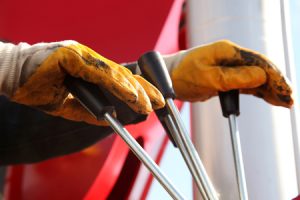[breadcrumb]
 How Can a Crane Operator Get Mesothelioma by Occupational Exposure to Asbestos?
How Can a Crane Operator Get Mesothelioma by Occupational Exposure to Asbestos?
Crane operators are amid some of the heavy equipment operators whose jobs potentially exposed them to asbestos. They operate machines that lift and move materials and products. Asbestos was once included in over 4,000 construction materials due to its affordability, resistance to heat and chemical reactions, and versatility. When crane operators lifted these contaminated materials, they often disturbed asbestos so microscopic fibers floated in the air and were inhaled by crane operators and other workers on site.
Many crane operators work on demolition and renovation sites. Older buildings often contain these materials, so crane operators continue to be exposed to asbestos. Others worked on ships where asbestos was also prevalent. Asbestos was used in the building of military, commercial and private ships. Others worked among demolition crews after the 9/11 terrorist attacks where they were exposed to asbestos materials.
Other common locations where crane operators work where asbestos use was once prevalent include:
- Dockyards
- Steel mills
- Iron mills
- Railroads
- Power companies
- Highway and bridge construction
Crane operators often worked in environments where other workers may have filled the air with asbestos dust, such as around bricklayers, construction workers and insulation workers.
Additionally, asbestos was also included in crane parts that operators used on an every day. Crane operators who serviced their machine or checked their brakes could have been exposed to asbestos.
Locations in the United States for the Highest Employment Rates for Crane Operators
There are currently 43,660 crane and tower operators, according to the U.S. Bureau of Labor Statistics. This job has an expected growth rate of 10% from 2018 to 2028, which is much faster than the average occupational projection.
States with the highest employment rates for construction equipment operators include:
- Texas
- California
- Pennsylvania
- Louisiana Florida
Similar Occupations as Crane Operators
Occupations that are similar to crane operators include:
- Bulldozer operators
- Construction laborers
- Electricians
- Forklift drivers
- Heavy machine operators
Lawsuits and Settlements Involving Crane Operators and Mesothelioma
Crane operators and other heavy machine operators have filed lawsuits against asbestos product manufacturers and other parties who are legally responsible for their exposure to asbestos. Some notable verdicts and settlements include:
- A man who worked at a steel plant in Chicago as a crane operator received a sizable verdict of over $1 million after the man developed mesothelioma from asbestos exposure at his job.
- A jury awarded a farm worker and heavy machine operator $38 million in 2003 after he developed mesothelioma and sued 13 asbestos manufacturers. His verdict included $16 million in punitive damages.
- In 2017, a Washington jury awarded $81.5 million to the family of a heavy machine operator against defendants NAPA and Genuine Parts. The man worked as an excavator and operated and repaired construction equipment where he was exposed to asbestos from friction parts on these vehicles. He died from mesothelioma.
- In 2005, a San Francisco jury imposed a judgment of $2.2 million against Caterpillar after finding the company responsible for a heavy machine operator’s exposure to asbestos that occurred when he performed routine brake and repair work on the machinery.
Studies Related to Crane Operators and Asbestos
There have been several studies regarding the connection between asbestos and the construction industry. Some of these studies include:
- The Agency for Toxic Substances and Disease Registry reports that most occupational exposure today occurs during construction work, including the repair, renovation, removal or maintenance of asbestos-containing products that were installed decades ago. Crane operators often work on these projects.
- Recent studies conducted by the Centers for Disease Control and Prevention (CDC) have attributed 70% to 80% of asbestos exposure that occurred during the 1900s to construction work.
- “Domestic Asbestos Exposure: A Review of Epidemiologic and Exposure Data” studied how people were exposed to asbestos, including through construction work.
Types of Asbestos Products Used by Crane Operators
Crane operators may have been exposed to a variety of products that contained asbestos, including:
- Cranes
- Crane engines
- Gaskets
- Brakes
- Engine components
- Hoisting apparatus
- Clutches
- Insulation
- Ceiling and floor tiles
- Fireproofing materials
- Dry cement powder
- Glues, adhesives and sealants
- Joint compound
Manufacturers of Asbestos Products Used by Crane Operators
Crane operators who were exposed to asbestos from the machine itself may have a claim against the manufacturer of the crane, such as Caterpillar, or the maker of the automotive parts that were contaminated with asbestos.
Those who were exposed to asbestos from the materials that they moved around may have a claim against the manufacturer of the contaminated asbestos product. Some of the major asbestos manufacturers who have been named in asbestos litigation include:
- Abex Corporation
- Celotex Corp.
- CertainTeed Corporation
- GAF Corporation
- Garlock Sealing Technologies
- Johns Manville
- T. Thorpe and Son, Inc.
- National Gypsum Corporation
- Owens Corning Corporation
- Pittsburgh Corning
- UNARCO
- Union Carbide
- R. Grace & Co.
